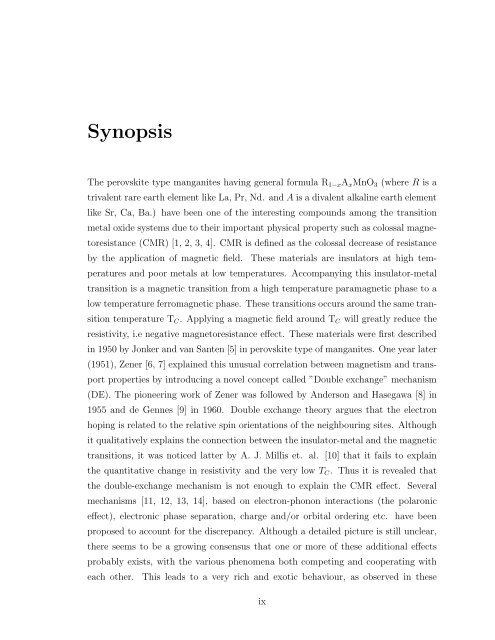PHYS07200604007 Manas Kumar Dala - Homi Bhabha National ...
PHYS07200604007 Manas Kumar Dala - Homi Bhabha National ...
PHYS07200604007 Manas Kumar Dala - Homi Bhabha National ...
You also want an ePaper? Increase the reach of your titles
YUMPU automatically turns print PDFs into web optimized ePapers that Google loves.
Synopsis<br />
The perovskite type manganites having general formula R 1−x A x MnO 3 (where R is a<br />
trivalent rare earth element like La, Pr, Nd. and A is a divalent alkaline earth element<br />
like Sr, Ca, Ba.) have been one of the interesting compounds among the transition<br />
metal oxide systems due to their important physical property such as colossal magnetoresistance<br />
(CMR) [1, 2, 3, 4]. CMR is defined as the colossal decrease of resistance<br />
by the application of magnetic field. These materials are insulators at high temperatures<br />
and poor metals at low temperatures. Accompanying this insulator-metal<br />
transition is a magnetic transition from a high temperature paramagnetic phase to a<br />
low temperature ferromagnetic phase. These transitions occurs around the same transition<br />
temperature T C . Applying a magnetic field around T C will greatly reduce the<br />
resistivity, i.e negative magnetoresistance effect. These materials were first described<br />
in 1950 by Jonker and van Santen [5] in perovskite type of manganites. One year later<br />
(1951), Zener [6, 7] explained this unusual correlation between magnetism and transport<br />
properties by introducing a novel concept called ”Double exchange” mechanism<br />
(DE). The pioneering work of Zener was followed by Anderson and Hasegawa [8] in<br />
1955 and de Gennes [9] in 1960. Double exchange theory argues that the electron<br />
hoping is related to the relative spin orientations of the neighbouring sites. Although<br />
it qualitatively explains the connection between the insulator-metal and the magnetic<br />
transitions, it was noticed latter by A. J. Millis et. al. [10] that it fails to explain<br />
the quantitative change in resistivity and the very low T C . Thus it is revealed that<br />
the double-exchange mechanism is not enough to explain the CMR effect. Several<br />
mechanisms [11, 12, 13, 14], based on electron-phonon interactions (the polaronic<br />
effect), electronic phase separation, charge and/or orbital ordering etc. have been<br />
proposed to account for the discrepancy. Although a detailed picture is still unclear,<br />
there seems to be a growing consensus that one or more of these additional effects<br />
probably exists, with the various phenomena both competing and cooperating with<br />
each other. This leads to a very rich and exotic behaviour, as observed in these<br />
ix
















